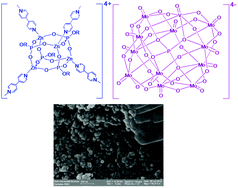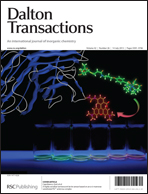A facile synthetic strategy for the generation of a new class of inorganic–organic–inorganic hybrids is reported. Replacement of labile DMSO ligands from the preformed Double-Four-Ring (D4R) zinc phosphate cluster [Zn(dipp){(CH3)2SO}]4 by the addition of 4-aminopyridine (4-ampyr) results in the isolation of another discrete D4R cluster [Zn(dipp)(4-ampyr)]4 (1), which forms a hydrogen-bonded framework in solid-state. If 1-methyl-4,4′-bipyridinium salts are employed instead, tetra-cationic D4R cluster [Zn(dipp)(L)]4[PF6]4 (2) and [Zn(dipp)(L)]4[ClO4]4 (3) (L = 1-methyl-4,4′-bipyridinium, dipp = 2,6-di-iso-propylphenylphosphate) are isolated. Compound 2 was reacted with three different polyoxometalates, [TBA]4[Mo8O26] (POM-1), [TBA]4[PMo11VO40] (POM-2), and [TBA]4[SiMo12O40] (POM-3) to obtain amorphous hybrids, [Zn(dipp)(L)]4[Mo8O26] (4), [Zn(dipp)(L)]4[PMo11VO40] (5), and [Zn(dipp)(L)]4[SiMo12O40] (6), respectively. All the hybrid materials have been characterized by analytical and spectroscopic studies. The molecular structure of 1 has also been determined by single-crystal XRD measurements. N2 gas sorption analyses show moderate BET surface area and also establish the mesoporous nature of the hybrids 4–6. The catalytic potential of hybrids 4, 5 and 6 has been explored towards epoxidation of cyclohexene.

You have access to this article
 Please wait while we load your content...
Something went wrong. Try again?
Please wait while we load your content...
Something went wrong. Try again?


 Please wait while we load your content...
Please wait while we load your content...